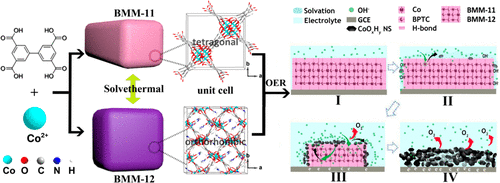当前位置:
X-MOL 学术
›
Inorg. Chem.
›
论文详情
Our official English website, www.x-mol.net, welcomes your
feedback! (Note: you will need to create a separate account there.)
Structural and Morphological Conversion between Two Co-Based MOFs for Enhanced Water Oxidation.
Inorganic Chemistry ( IF 4.3 ) Pub Date : 2020-02-13 , DOI: 10.1021/acs.inorgchem.9b03009 Li Zhong 1 , Junyang Ding 1 , Xian Wang 1 , Lulu Chai 1 , Ting-Ting Li 2 , Kongzhao Su 3 , Yue Hu 1 , Jinjie Qian 1 , Shaoming Huang 4
Inorganic Chemistry ( IF 4.3 ) Pub Date : 2020-02-13 , DOI: 10.1021/acs.inorgchem.9b03009 Li Zhong 1 , Junyang Ding 1 , Xian Wang 1 , Lulu Chai 1 , Ting-Ting Li 2 , Kongzhao Su 3 , Yue Hu 1 , Jinjie Qian 1 , Shaoming Huang 4
Affiliation

|
The rapid development of suitable and cheap water oxidation catalysts is of great significance in energy conversion and storage. In this context, herein we have synthesized two different types of metal-organic frameworks (MOFs, denoted as BMM-11 and BMM-12) constructed from the same metal salts (cobalt nitrate) and organic linkers (H4BPTC) at the similar solvothermal conditions. Interestingly, we learned that both crystalline materials can be conveniently converted into each other by a single-crystal-to-single-crystal transformation method at their corresponding synthetic conditions. Meanwhile, we applied them directly as electrocatalysts into OER application where the pure BMM-11 and BMM-12 can achieve a stable current density of 10 mA cm-2 with an overpotential of 0.362 and 0.393 V, respectively, during which MOF degradation unexpectedly occurs. After electrolysis, the following microscopic, spectroscopic, as well as electrochemical measurements confirm that these initial MOF precursors are rapidly transformed into the mixed phases of CoOxHy species consisting of CoOOH and Co(OH)2, which are essentially active components for OER performance. Finally, we have also considered other strategies to improve MOF-derived composites in oxygen evolution activity, including bimetallic doping and physical grinding strategy. The approach described here can further be extended to other cobalt-based MOFs-derived electrocatalysts for water splitting.
中文翻译:

两个基于钴的MOF之间的结构和形态转化,以增强水的氧化作用。
合适且廉价的水氧化催化剂的快速开发对能量转换和存储具有重要意义。在此背景下,我们在相似的溶剂热条件下,由相同的金属盐(硝酸钴)和有机连接基(H4BPTC)合成了两种不同类型的金属有机骨架(MOF,分别表示为BMM-11和BMM-12) 。有趣的是,我们了解到,两种晶体材料可以在其相应的合成条件下通过单晶至单晶转化方法方便地相互转化。同时,我们将它们直接用作电催化剂到OER应用中,其中纯BMM-11和BMM-12可以实现10 mA cm-2的稳定电流密度,过电势分别为0.362和0.393 V,在此期间MOF意外发生降解。电解后,以下的显微镜,光谱和电化学测量结果证实,这些初始MOF前驱体迅速转变为CoOxHy物种的混合相,其中CoOxHy物种由CoOOH和Co(OH)2组成,它们是OER性能的基本活性成分。最后,我们还考虑了其他方法来改善MOF衍生的复合材料的析氧活性,包括双金属掺杂和物理研磨策略。此处描述的方法可以进一步扩展到用于水分解的其他钴基MOF衍生的电催化剂。基本上是提高OER性能的有效组件。最后,我们还考虑了其他方法来改善MOF衍生的复合材料的析氧活性,包括双金属掺杂和物理研磨策略。此处描述的方法可以进一步扩展到用于水分解的其他钴基MOF衍生的电催化剂。基本上是提高OER性能的有效组件。最后,我们还考虑了其他方法来改善MOF衍生的复合材料的析氧活性,包括双金属掺杂和物理研磨策略。此处描述的方法可以进一步扩展到用于水分解的其他钴基MOF衍生的电催化剂。
更新日期:2020-02-13
中文翻译:

两个基于钴的MOF之间的结构和形态转化,以增强水的氧化作用。
合适且廉价的水氧化催化剂的快速开发对能量转换和存储具有重要意义。在此背景下,我们在相似的溶剂热条件下,由相同的金属盐(硝酸钴)和有机连接基(H4BPTC)合成了两种不同类型的金属有机骨架(MOF,分别表示为BMM-11和BMM-12) 。有趣的是,我们了解到,两种晶体材料可以在其相应的合成条件下通过单晶至单晶转化方法方便地相互转化。同时,我们将它们直接用作电催化剂到OER应用中,其中纯BMM-11和BMM-12可以实现10 mA cm-2的稳定电流密度,过电势分别为0.362和0.393 V,在此期间MOF意外发生降解。电解后,以下的显微镜,光谱和电化学测量结果证实,这些初始MOF前驱体迅速转变为CoOxHy物种的混合相,其中CoOxHy物种由CoOOH和Co(OH)2组成,它们是OER性能的基本活性成分。最后,我们还考虑了其他方法来改善MOF衍生的复合材料的析氧活性,包括双金属掺杂和物理研磨策略。此处描述的方法可以进一步扩展到用于水分解的其他钴基MOF衍生的电催化剂。基本上是提高OER性能的有效组件。最后,我们还考虑了其他方法来改善MOF衍生的复合材料的析氧活性,包括双金属掺杂和物理研磨策略。此处描述的方法可以进一步扩展到用于水分解的其他钴基MOF衍生的电催化剂。基本上是提高OER性能的有效组件。最后,我们还考虑了其他方法来改善MOF衍生的复合材料的析氧活性,包括双金属掺杂和物理研磨策略。此处描述的方法可以进一步扩展到用于水分解的其他钴基MOF衍生的电催化剂。






























 京公网安备 11010802027423号
京公网安备 11010802027423号